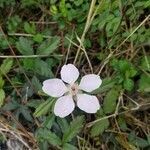Stems erect or nearly so, to 1 m, heavily armed with stout, straight or hooked prickles from a widely expanded base; primocane lvs 3(5)-foliolate, on a strongly armed petiole; terminal lfl seldom over 5 cm, rhombic to obovate, widest well above the middle, truncate to rounded or broadly obtuse, short-apiculate, or rarely merely acute, cuneate from the broadest part with nearly straight margins to the base, simply serrate in the distal half with rather broad low teeth, entire in the basal half, densely white-or gray-tomentose beneath; infl of usually 1–3 fls on ascending pedicels, all or mostly subtended by lvs with expanded blade. Dry, sandy soil, chiefly on the coastal plain; Conn. and L.I. to Fla. and Ala.; disjunct in Hillsboro Co., N.H. May–July. (R. longii; R. sejunctus)
Shrub, up to 4 m high. Stems erect; deeply ridged, thorny. Leaves compound; blade palmately pinnate, usually with 3 leaflets; leaflets discolorous, margins strongly dentate. Flowers: 2-5 at ends of short leafy shoots, either axillary or terminal; petals much longer than sepals, white rarely pink; Nov., Dec. Fruit black, adhering to torus.
A shrub. It grows 1-1.5 m tall. The stems have prickles. It often loses many leaves during the year. There are 3-5 leaflets. The fruit is black and 1-2 cm across with 15-50 small fruitlets.
Erect shrublet, up to 1.5 m high. Leaves 3-foliolate, leaflets discolorous, margin strongly dentate. Corolla distinctly longer than calyx. Fruits black, adhering to torus. Flowers white.
Perennial shrub, up to 4 m high. Leaves green. Flowers white and inconspicuous. Flowering time Dec.-Mar. Fruit conspicuous, red maturing to black.

